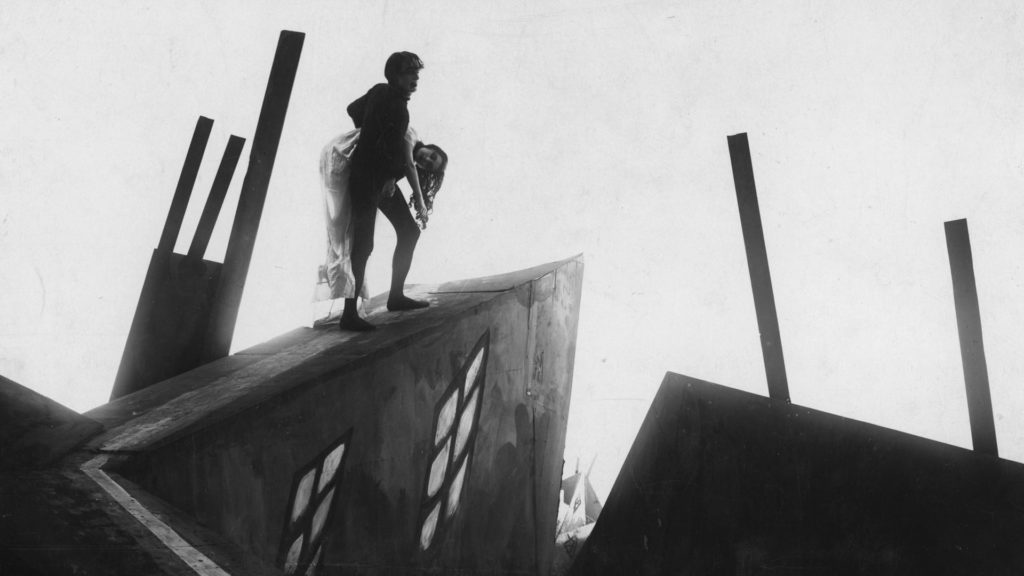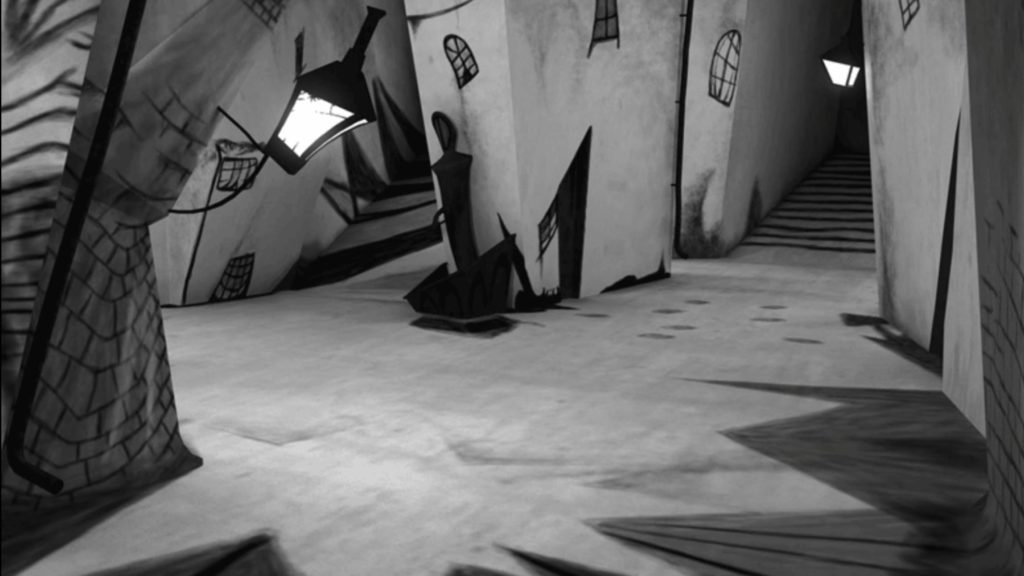In the the late 1910s and 1920s, a bunch of German filmmakers invented the tone and aesthetics of horror movies amidst postwar defeat drudgery in a movement called “German expressionism.” These films used anti-realism and theatricality to heighten the storytelling and mood of their stories. The brilliant filmmakers who pioneered the movement (most notably Fritz Lang), shared the mentality of “expressionist” painters seeking to capture subjective experiences rather than objective realities.
The Cabinet of Dr. Caligari, an outstanding example from the movement directed by Robert Wiene, is an absolute masterpiece of production design and aesthetics. Everything is sharp edges and jagged angles, all so inhuman and inorganic. It’s truly unlike anything else in cinema; just relentless with disorienting and imbalanced settings. It’s not that the film builds to a few moments that use a distorted mise en scene — it’s that every single shot of the film has that effect.
The use of lighting and shadows play a crucial role, too. Bleak, sharp shadows build the sense of a world in disarray, with the very essence of modern life dangerous and falling apart at the seams. Many sets also have a heavily artificial, painted look that expands the expressionistic feeling, as if this film is a Edvard Munch painting brought to life.

The story fits perfectly with these disorienting and evocative visual ideas: A mysterious carnival barker by the name of Dr. Caligari (Werner Krauss) has a coffin which houses a man named Cesare (Conrad Veidt) in a deep, deathlike sleep. Dr. Caligari’s trick is raising Cesare to sleep-walking life.
Shortly after Dr. Caligari’s show premiers, people in the village start getting stabbed by an unknown assailant in the middle of the night, including the friend of Francis (Friedrich Feher), our protagonist.
As the plot progresses, dual realities begin to emerge — a false one constructed by the modern institutions, where an ordinary local thug is doing the murders, and one constructed by Francis, which blames Caligari. The truth of Dr. Caligari’s villainy comes to light, and his sleep-walking minion Cesare is stopped just before murdering Francis’s lover, Jane. Worse, we learn that Caligari is the director of the local mental hospital and asylum, where he plucked Cesare from — the very man who should be curing the modern poisons of the world is perpetrating them.

That would seem to be it, but (spoiler warning!) in a twist ending building upon a framing intro sequence, we learn that Francis, himself, is an asylum patient — and he’d hallucinated the whole story. Every character we had seen existed in a different form in the asylum, including a benevolent version of Dr. Caligari.
It’s an astonishing final twist, if a bit old-hat these days: “It was all a dream!!” But it’s also a troublesome ending; it cuts against every idea laid out in both the storytelling and the visual design leading up to that: That modern society and corrupted institutions are bringing us to darkness in a world that’s increasingly inhuman and disorienting; and that those we should be able to trust are the ones tearing us down and constructing false realities. But by making the human center of the film the actual lunatic and turning the villainous doctor into a kindly caretaker, those concepts are flipped on their head in a way that undermines their impact. The institutions are, in fact, innocent; the people deluded?
Despite the weird tone of the final scene, The Cabinet of Dr. Caligari is an absolute must-watch, a riveting horror story from start to end. Even with the befuddling final twist, the movie offers an overwhelming sensation of modernity crumbling upon the viewer.

If everything about the film’s aesthetic and cinematography is unparalleled brilliance and innovation, other parts of the craft are less adventurous, even grading on a curve. The camera holds still essentially the entire time, featuring mostly medium shots, as if we’re watching a stage. Though this heightens the film’s theatricality, it flattens its cinematic quality. Imagine this film with pans and zooms!
The film also overuses irises — the technique of blacking out all but a specific portion of the frame to draw our focus — to the point of distraction.
Nonetheless, the production design is so good that it easily overcomes the basic direction. The film’s overall visual effect is truly remarkable and unique.
While I have some reservations, mostly with the ending, I can say without reservation that this film is a treasure and worth watching by anyone who enjoys horror or classic films. It’s one of the earliest feature films in the history of the medium that I adore purely as a movie lover rather than an aspiring film historian.
Is It Good?
Very Good (6/8)
A few words on "Is It Good?" ratings for early cinema.
Dan is the founder and head critic of The Goods. Follow Dan on Letterboxd. Join the Discord for updates and discussion.


2 replies on “The Cabinet of Dr. Caligari (1920)”
I would not say that the ending undermines the movie by any means.
The way it is filmed, there is enough ambiguity to allow the reading that the Director has forcefully put Franzis there to shut him up.
I’ve heard this take before, that it’s some sort of double twist meant to disguise Dr. Caligari’s real intents. I really did not see it. If you have any more thoughts on the ambiguity I’d love to hear it. I’ll watch again at some point and think about this perspective when the ending approaches.